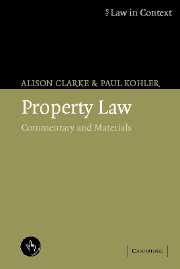Book contents
- Frontmatter
- Contents
- Preface
- Acknowledgments
- Table of cases
- Table of statutes
- Table of statutory instruments
- Table of treaties
- Table of EC legislation
- Part 1 The concept of property
- Part 2 The nature of proprietary interests
- 5 Personal and proprietary interests
- 6 Ownership
- 7 Possession
- 8 Fragmentation of ownership
- 9 Recognition of new property interests
- Part 3 The acquisition and disposition of property interests
- Part 4 Proprietary relationships
- Bibliography
- Index
9 - Recognition of new property interests
Published online by Cambridge University Press: 05 June 2012
- Frontmatter
- Contents
- Preface
- Acknowledgments
- Table of cases
- Table of statutes
- Table of statutory instruments
- Table of treaties
- Table of EC legislation
- Part 1 The concept of property
- Part 2 The nature of proprietary interests
- 5 Personal and proprietary interests
- 6 Ownership
- 7 Possession
- 8 Fragmentation of ownership
- 9 Recognition of new property interests
- Part 3 The acquisition and disposition of property interests
- Part 4 Proprietary relationships
- Bibliography
- Index
Summary
In this chapter, we will consider the essentially dynamic quality of property. While it is important that the categories of property are clear and certain, it does not follow from this that the list should be eternally fixed and incapable of development. As you will see, there is constant pressure to recognise new property interests, although, for reasons we shall examine, it is not easy for an interest to cross the threshold into property. However, the history of property bears witness to the constant expansion of the range of property interests in response to society's changing needs and increasing complexity.
In section 9.1 we will consider the reasons why the property label is (and is not) attached to certain interests. While in section 9.2, we shall illustrate the dynamic nature of property by examining examples of interests that have (at least intermittently!) been accorded proprietary status. We will contrast this, in section 9.3 where we consider the law's general reluctance to embrace new property interests, with an example that did not even fleetingly cross the property threshold. This will enable us to examine the principles which underscore the recognition of new property interests before subjecting them to a critical evaluation, in section 9.4, when we consider a comparative and economic study which casts doubt on much that has gone before. Finally, in section 9.5 we will turn to speculate on possible new directions in which the law of property might develop.
- Type
- Chapter
- Information
- Property LawCommentary and Materials, pp. 345 - 380Publisher: Cambridge University PressPrint publication year: 2005



